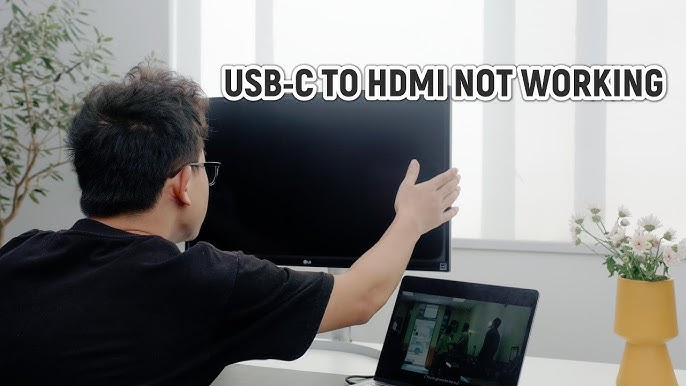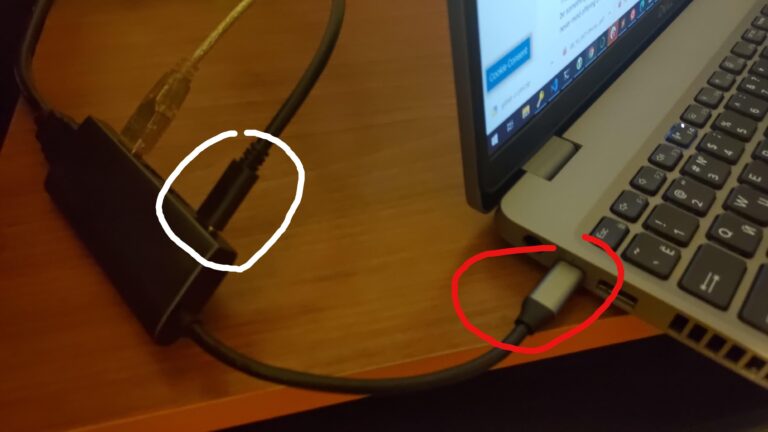Ensure the USB-C cable is properly connected and check for driver updates. Restarting the device might resolve the issue.
USB-C monitors offer excellent connectivity and performance but may sometimes fail to be detected. This issue can stem from various sources, including faulty cables, outdated drivers, or incorrect settings. Users often experience frustration when their devices don’t recognize the monitor.
Simple troubleshooting steps can usually resolve the problem. Ensuring the USB-C cable is securely connected and checking for the latest driver updates are essential. Restarting both the monitor and the connected device can also help. In some cases, testing the monitor with another device can identify whether the issue lies with the monitor or the original device.

Credit: m.youtube.com
Common Causes
Having trouble with your USB-C monitor not being detected? There are several common causes for this issue. Understanding these can help you troubleshoot effectively and get your monitor working again.
Cable Issues
One of the most common causes is a faulty cable. USB-C cables can wear out or get damaged. Ensure your cable is in good condition.
- Check for visible damage on the cable.
- Try using a different USB-C cable.
- Ensure the cable supports video output.
Not all USB-C cables are created equal. Some are designed only for charging and data transfer, not video. Make sure your cable supports the required functions.
Port Malfunctions
Another common issue is malfunctioning ports. Both the monitor and the computer can have port issues.
Steps to check port functionality:
- Inspect the USB-C port for dirt or debris.
- Try connecting another device to the same port.
- Use a different USB-C port if available.
If the port is damaged, you may need a repair or replacement. Regular maintenance can prevent many port-related issues.

Credit: forums.developer.nvidia.com
Initial Checks
Experiencing issues with your USB-C monitor not being detected can be frustrating. Before diving into advanced troubleshooting, perform some initial checks. These steps often resolve common issues and save time.
Verify Connections
First, ensure all connections are secure. Check the USB-C cable and ports. A loose connection can often cause detection issues.
- Inspect both ends of the USB-C cable.
- Ensure the cable is fully inserted into the ports.
- Check for any visible damage on the cable.
Try using a different USB-C cable if available. Sometimes the cable itself might be the problem.
Restart Devices
A simple restart can fix many detection issues. Restart both the monitor and the connected device.
- Unplug the USB-C cable from both devices.
- Power off the monitor.
- Restart the connected device (computer, tablet, etc.).
- Power on the monitor.
- Reconnect the USB-C cable.
Ensure the device recognizes the monitor after restarting.
Driver Updates
Updating drivers can resolve the issue of your USB-C monitor not being detected. Drivers are essential for communication between hardware and the operating system. Let’s explore how updating drivers can help, focusing on Graphics Drivers and USB-C Drivers.
Graphics Drivers
Your graphics driver plays a crucial role in display detection. An outdated graphics driver can cause the USB-C monitor to remain undetected. Follow these steps to update your graphics driver:
- Open the Device Manager on your computer.
- Expand the Display Adapters section.
- Right-click your graphics card and select Update driver.
- Choose Search automatically for updated driver software.
- Follow the on-screen instructions to complete the update.
Updating your graphics driver can improve compatibility with your USB-C monitor. Always ensure you have the latest driver version.
USB-C Drivers
USB-C drivers are equally important. They manage the data transfer between your computer and the monitor. To update your USB-C drivers, follow these steps:
- Open Device Manager on your computer.
- Expand the Universal Serial Bus controllers section.
- Right-click on your USB-C host controller and select Update driver.
- Choose Search automatically for updated driver software.
- Follow the on-screen instructions to complete the update.
Keeping your USB-C drivers updated ensures proper communication with your monitor. This step can resolve many detection issues.
In summary, regularly updating both your graphics and USB-C drivers can solve the problem of your USB-C monitor not being detected. These updates are easy to perform and can enhance your device’s performance.
Operating System Settings
When your USB-C monitor is not detected, the problem often lies within the operating system settings. Adjusting these settings can sometimes resolve the issue quickly. Let’s dive into the specific areas you should check.
Display Settings
First, navigate to your Display Settings. This is where your operating system manages connected displays. Ensure that your USB-C monitor is detected and listed. If it isn’t, try the following steps:
- Right-click on the desktop and select ‘Display settings’.
- Look for the ‘Detect’ button and click it.
- Ensure the multiple displays dropdown is set correctly.
If your monitor appears but still doesn’t work, check the resolution and refresh rate settings. Sometimes, the monitor might not display properly due to incorrect settings.
Power Management
Power Management settings can also affect the detection of your USB-C monitor. Power-saving features might turn off the monitor to save energy. Follow these steps to adjust the settings:
- Open the Control Panel.
- Navigate to ‘Hardware and Sound’.
- Select ‘Power Options’.
- Choose a power plan and click on ‘Change plan settings’.
- Click on ‘Change advanced power settings’.
Within the advanced settings, expand ‘USB settings’ and ‘USB selective suspend setting’. Ensure both are set to ‘Disabled’. This stops the system from turning off your USB-C ports.
Additionally, check the PCI Express settings. Expand it and set ‘Link State Power Management’ to ‘Off’. This ensures your USB-C monitor gets consistent power.
Following these steps should help resolve detection issues with your USB-C monitor.
Hardware Compatibility
Understanding hardware compatibility is crucial when your USB-C monitor is not detected. This section will help you troubleshoot by focusing on two main areas: monitor specifications and device compatibility.
Monitor Specifications
Before diving into solutions, check your monitor’s specifications. Ensure your monitor supports USB-C input. Not all USB-C ports support video output. Some only offer charging or data transfer.
Refer to your monitor’s manual or spec sheet. Look for terms like DisplayPort over USB-C or Thunderbolt 3. These indicate the monitor can handle video signals through USB-C.
| Specification | Check |
|---|---|
| USB-C Video Support | Yes |
| Resolution | 4K, 1080p, etc. |
| Refresh Rate | 60Hz, 144Hz, etc. |
Device Compatibility
Next, ensure your device is compatible with the monitor. Not all laptops or tablets support video output via USB-C. Check your device’s specifications.
Look for terms like DisplayPort Alt Mode or Thunderbolt 3 support. These indicate your device can send video signals through USB-C.
- Check your device manual for USB-C capabilities.
- Ensure your device supports DisplayPort Alt Mode.
- Verify that drivers and firmware are up to date.
If both your monitor and device support video over USB-C, but the monitor is still not detected, it might be a cable issue. Ensure you are using a high-quality USB-C cable that supports video.
Bios And Firmware
Having trouble with your USB C monitor not being detected? The issue might lie in your BIOS or firmware. These components control your hardware and ensure everything runs smoothly.
Bios Settings
The BIOS (Basic Input/Output System) is essential. It manages the basic functions of your computer. If your USB C monitor is not detected, checking the BIOS settings is crucial.
To access the BIOS:
- Restart your computer.
- Press the BIOS key during startup (often F2, F10, or DEL).
- Navigate to the Advanced Settings or Peripherals.
- Ensure USB ports are enabled.
- Save changes and exit the BIOS.
Firmware Updates
Firmware is the software that runs your hardware. Keeping it updated ensures compatibility and performance. An outdated firmware might be the reason your USB C monitor is not detected.
To update your firmware:
- Visit your motherboard or laptop manufacturer’s website.
- Search for the latest firmware updates.
- Download the update file.
- Follow the instructions to install the update.
Updating the firmware can solve many hardware issues. It keeps your system running smoothly.
Alternative Cables
When your USB-C monitor is not detected, trying alternative cables can solve the issue. Different cables offer varied quality and length, impacting performance.
Cable Quality
Cable quality plays a significant role in detecting your USB-C monitor. High-quality cables ensure stable connections and better data transfer rates. Poor-quality cables can lead to detection issues and signal loss.
To choose a good cable, look for certified cables. Certified cables meet industry standards. They provide reliable performance. Avoid cheap cables. These often lack proper shielding and materials.
| Quality Level | Features |
|---|---|
| High | Certified, Durable Materials, Proper Shielding |
| Medium | Partially Certified, Decent Materials |
| Low | Non-certified, Poor Materials |
Cable Length
Cable length affects the performance of your USB-C monitor. Shorter cables generally provide better performance. They reduce signal loss and interference.
Longer cables can cause signal degradation. This leads to detection problems. Choose a cable length that suits your setup but isn’t too long. For most setups, a 1-2 meter cable works best.
- Less than 1 meter: Best for short distances.
- 1-2 meters: Ideal for most setups.
- More than 2 meters: This may require signal boosters.
Third-party Software
Third-party software can help resolve issues with your USB-C monitor. These tools can diagnose, manage, and optimize your display settings. They are essential for troubleshooting and improving your monitor’s performance.
Display Management Tools
Display management tools let you control multiple monitors easily. These tools help you configure resolutions, orientations, and display modes. Popular software includes:
- DisplayFusion: Offers comprehensive multi-monitor management.
- UltraMon: Provides added features for multi-monitor setups.
- MultiMonitorTool: Lightweight utility for basic display tasks.
Install and run these tools to detect and manage your USB-C monitor. They often resolve detection issues by adjusting settings automatically.
Diagnostic Software
Diagnostic software helps identify hardware and software issues. These tools scan your system to pinpoint problems with your USB-C monitor. Here are a few reliable options:
- HWMonitor: Monitors hardware performance and detects faults.
- HWiNFO: Provides detailed system diagnostics and reports.
- Speccy: Offers a snapshot of your system’s health.
Run these diagnostic tools to check for any hardware or driver issues. They can guide you to specific solutions based on their findings.
Professional Help
Sometimes, troubleshooting your USB C monitor can be overwhelming. Professional help can save you time and stress. Here are some ways to get expert assistance.
Manufacturer Support
Contact the manufacturer if your USB C monitor is not detected. They offer specific help for their products. You can find their contact information on their website. Here’s a quick guide to reach them:
| Manufacturer | Support Website | Contact Number |
|---|---|---|
| Dell | dell.com/support | 1-800-624-9897 |
| HP | support.hp.com | 1-800-474-6836 |
| Samsung | samsung.com/us/support | 1-800-726-7864 |
They may offer remote assistance or guide you through the troubleshooting steps.
Local Technicians
If manufacturer support does not resolve the issue, consider a local technician. They can offer in-person help. Here are the benefits of using a local technician:
- Quick response time
- Hands-on troubleshooting
- Personalized service
Many tech shops have experienced staff. They are familiar with common monitor issues. To find a local technician, you can:
- Search online for local tech support
- Ask friends or family for recommendations
- Check local business directories
Ensure the technician has good reviews and reasonable rates.
Preventive Measures
Preventive measures can help ensure your USB-C monitor remains functional. By taking simple steps, you can avoid common issues like your monitor not being detected.
Regular Updates
Regular updates are crucial for keeping your devices compatible. Ensure your operating system is up-to-date. Updating your drivers is also essential. Manufacturers release updates to fix bugs and improve performance.
- Check for updates once a month.
- Install firmware updates for your monitor.
- Use automatic update tools if available.
Proper Handling
Proper handling of your USB-C cables and ports can prevent damage. Damaged cables and ports often cause detection issues.
- Always plug and unplug cables gently.
- Store cables in a safe place when not in use.
- Avoid bending or twisting the cables.
Inspect your cables and ports regularly. Look for signs of wear and tear. Replace damaged cables immediately.
Additional Tips
Here are some additional tips to keep your USB-C monitor working:
- Use certified cables and adapters.
- Keep your monitor and computer clean.
- Ensure proper ventilation to avoid overheating.

Credit: www.reddit.com
Frequently Asked Questions
Why Is My USB-C monitor Not Detected?
Your USB-C monitor might not be detected due to outdated drivers, incorrect settings, or a faulty cable. Ensure drivers are updated, check connections, and verify monitor settings.
How Do I Get My USB-C to Work On My Monitor?
Connect the USB-C cable to both your monitor and device. Ensure the monitor is set to the correct input source. Update your device’s drivers if necessary. Check for any damaged cables or ports.
Why Is My USB-C to HDMI monitor Not Detecting?
Ensure your USB-C port supports video output. Update your drivers. Check the cable and adapter for damage. Verify monitor input settings.
Conclusion
Troubleshooting a USB-C monitor not detected can be challenging but manageable. Follow the steps outlined to resolve the issue effectively. Always ensure your cables and ports are functioning properly. By staying proactive, you can maintain seamless connectivity and enhanced productivity.
For persistent problems, consulting a professional may be necessary.

Hello Good People! This is Pavel and Welcome to PC Delight!
I’m an Electronics Engineer by profession with a passion for Gaming & PC builds. When I came up with the idea for PC Delight, it was my goal to share & offer the very best PC building ideas to tech-loving people like myself.
Since my school days, I’ve been just addicted to gaming & PCs. That leads me to experiment with various ways around the very niche, resulting in great productivity. And I’m here to share those practical experiences. So that next time you start some experiment with your PC builds or struggle to cope with a certain game, I’m here with the solutions. With these philosophies, I started my journey in 2017 and just kept going.
